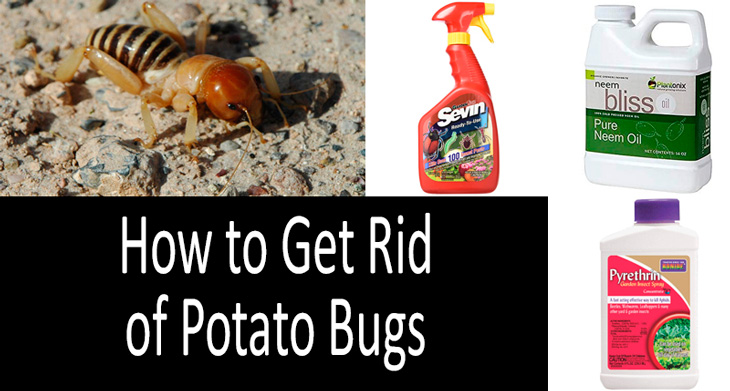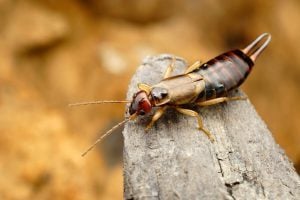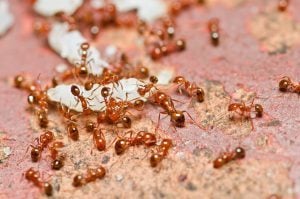These black-and-yellow striped beetles feed on potato crops and not only cause significant damage to potato leaves but can also kill the whole plant. However, if you do not grow potatoes, it doesn’t mean you have nothing to worry about. They can infest tomatoes, peppers, and some other plants as well as invade your house and become a nuisance. This guide analyzes methods of potato bug control both indoors and outdoors. You will learn about the most efficient insecticides that will not only kill potato bugs but also can be safely applied to foliage.
How to get rid of potato bugs? The major problem with this species of beetles is that they quickly develop resistance to insecticides.
Keep in mind that the best way to get rid of potato bugs is to take an integrated approach and alternate insecticides with different ingredients and modes of action.
Your pest management plan may include an azadirachtin-based product that prevents insect molting + a pyrethrin insecticide that causes paralysis in bugs + an insecticide with carbaryl that disrupts their nervous system.
We recommend opting for this three insecticides.
|
1. Organic Neem Bliss 100% Pure Cold Pressed Neem Seed Oil |
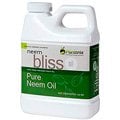 Check the current price |
|
2. Bonide (BND857) – Pyrethrin Garden Insect Spray Mix |
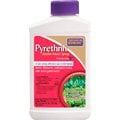 Check the current price |
|
3. Sevin Trigger Spray Bug Killer |
 Check the current price |
How to Get Rid of Potato Bugs Inside the House
These beetles can invade your house, settling in the bathroom, basement, and crawl spaces. Keep in mind that it is damp and humid places that attract potato bugs. Depending on the level of infestation, you can take the following steps.
- Vacuum up these beetles using a long hose attachment like the Workshop WS25022A Wet Dry Vacuum Hose. It is a super long 20-foot hose that will allow you to reach any area in your house, no matter where the power outlet is. The item will suit any standard vacuum with the 2-1/2-inch inlet port opening. The hose comes with a locking tab that secures it tightly to the device so that you could safely move it around. The only downside to this method is that it allows you to remove only a limited number of bugs. But it works great when the infestation is small.
- Dehumidifiers are particularly helpful for those who want to get rid of potato bugs in the basement. They thrive only in humid environments and will leave your place as soon as it gets dry. It is a common issue for homeowners to have a damp basement because of water leaks and high moisture penetration. Not all dehumidifiers can deal with large spaces. You should opt for an appliance that, like the Frigidaire 50-Pint Dehumidifier, is designed for basements.
The device works great for spaces with an area of up to 3,000 square feet and is capable of removing up to 50 pints of water a day. Depending on the humidity level in the basement, you can switch between two fan speeds. The continuous drain mode and auto shut-off feature add to your comfort in using the dehumidifier.
- Inspect your basement and caulk all cracks and crevices you have discovered. Blocking entry points is essential for preventing potato bugs from getting into your house.
How to Get Rid of Potato Bugs in the Garden
Insecticides are widely used by homeowners to kill potato beetles, however, they are not always effective. Why? These pests rapidly develop resistance to most pesticides. But don’t give up! Ric Bessin from the University of Kentucky notes that rotating the insecticides used is key to success.
In fact, by simply switching between brands you will not make things better. It is crucial to use insecticides with different active ingredients. Moreover, these should be ingredients of different types and with a different mode of action. Repeated application of one type of insecticide may kill some bugs while others will stay alive and kicking. Increasing the dosage of insecticide is not an option either because it will develop resistance in bugs even more. The bottom line is that you should rotate insecticides of different types, using each of them only for short-term treatment.
Some products offer a unique mode of action, delaying the development of resistance. Carefully selected insecticides will remain effective for years. Now, let’s take a look at different types of ingredients that work against these beetles and can be included in your pest control plan.
Azadirachtin prevents insect molting
Azadirachtin is a chemical compound that naturally occurs in neem seeds. As a reference, neem is a tree that grows in India, Iran, and some other countries in the region. Azadirachtin works by interfering with insect molting and, therefore, should be applied to young larvae, not grown adults. Besides, the chemical has insect repelling properties. Since azadirachtin-based products are botanical insecticides, they are recommended for those who want to get rid of potato bugs on plants.
The Organic Neem Bliss insecticide contains pure neem seed oil with high azadirachtin content. It is a natural and pesticide-free product that is OMRI listed for organic use. You can apply it not only outdoors but also indoors when dealing with severe bug infestations in the house. The oil was derived using a cold-press extraction method, meaning it is of the highest possible quality. Since the insecticide is biodegradable, it should be applied more frequently than chemical ones — twice a month at a ratio of 1 teaspoon of insecticide per quart of water. Use it to treat leaves, including their undersides.
Pyrethrin kills by causing paralysis
Pyrethrin is a plant-derived organic compound that is used to control a broad range of pests. It kills instantly upon contact. The insecticide targets the bug’s nervous system, causing it to die from paralysis. This is a time-proven solution that has been used as an insecticide for over a century. Combining pyrethrin with piperonyl butoxide helps to prevent resistance to the insecticide. At low concentrations, it works as a good bug repellent.
The Bonide (BND857) – Pyrethrin Garden Insect Spray Mix is a potent concentrate that can be applied around ornamentals, trees, and flowers. With 1% pyrethrins and 10% piperonyl butoxide, the product is biodegradable and does leave almost no residue. Therefore, you can safely treat vegetables with the BND857 even on the day of harvest. One pint contains 8 ounces of a strong concentrated insecticide that needs to be diluted at a ratio of 1/4 cup of the solution to half a gallon of water.
Carbaryl disrupts the nervous system
Carbaryl is a chemical registered in the U.S. as far back as 80 years ago for pest control. This insecticide kills ants, ticks, mosquitoes, and beetles by disrupting the normal function of the insect’s nervous system. It is generally available in the form of dusts, liquids, and baits. It can be applied to fruits, vegetables, ornamentals as well as building foundations. In the U.S., carbaryl is recommended for food crops because it detoxifies quickly.
Most products containing this ingredient are sold under the brand name Sevin. You may try the Sevin Trigger Spray Bug Killer that comes with a comfortable grip. Unlike concentrates, it does not require mixing and is easy to use. The product targets over a hundred insect species, including beetles. It has proved to be effective against ornamental pests, vegetable pests, and pests living around outdoor residential areas.
Abamectin acts on the insect’s brain
Abamectin is a natural fermentation product of the soil bacterium Streptomyces avermitilis. While being highly toxic to insects, it is of low toxicity to humans and pets. Abamectin interferes with the neural transmission in insects, acting on specific synapse in the brain. It works against larvae and, therefore, should be applied early in the season. The insecticide is safe to use for vegetable, fruit, and ornamental crops.
The Syngenta – 25837 – Avid 0.15EC – Insecticide was designed to control mites but is also recommended for beetles. Formulated with 2.0% abamectin, it can be safely sprayed on both foliage and flowers. While being of low toxicity, the product kills on contact and provides longer protection than many other insecticides on the market. Apply the insecticide as soon as you notice young larvae of the potato beetle. Then, repeat the application once a week two or three times.
How to Get Rid of Potato Bugs Naturally
You may try to get rid of potato bugs without chemicals, especially when not dealing with a severe infestation. Here is what you can do.
- Remove beetles from plants by handpicking and drop them in a jar with soapy water. Inspect the undersides of the plant leaves. If you see yellowish eggs, remove them as well.
- Introduce natural enemies of potato bugs. Lady beetles (Lady bugs) feed on their eggs while Beauveria bassiana, a fungus growing naturally in soils, can kill both adults and larvae. The downside is that natural enemies will not significantly reduce the potato bug population. That is why this method is recommended for mild infestations or as a supplementary measure.
The BotaniGard 22WP Biological Insecticide contains spores of Beauveria bassiana strain GHA. It is intended for plant pest control and is effective even against those resistant to chemical insecticides. This product is a good way to get rid of potato bugs in soil. To be effective, the product should be reapplied several times, at least once a week throughout a month.
- Create physical barriers like trench traps before adult potato bugs emerge. The depth of such a trench should be one to two feet in depth and at least six inches in width. Make the trench in the shape of U or V. Bugs will fall into such a trap and will not be able to get out.
Rules for Getting Rid of Potato Bugs: Science-Based Effectiveness
Entomologists stress that timing is key to successful control of potato bugs. As scientists from the University of Minnesota say, all insecticides provide the best results when applied to young larvae. This is because the potato beetle eggs are not susceptible to treatment by chemical insecticides while adults are hard to kill. Besides, it makes sense to prevent damage that grown bugs can inflict. You can easily distinguish young larvae from grown adults. The former ones are red and black while the latter are pink and black.
Chemical insecticides have a longer-term action but are not always effective because potato bugs easily develop resistance to them. Botanical insecticides have a short-term effect but are safe to apply to vegetable, fruit, and ornamental crops. Entomologists from the University of Massachusetts Amherst recommend applying Azadiractin to control immature beetles and Spinosad that controls all stages of potato bugs. It is an insecticide based on chemical compounds that are found in soil bacteria called Saccharopolyspora spinosa. Spinosad is toxic to insects as it affects their nervous system, causing their muscles to flex uncontrollably. The insect become paralyzed and die.
Dr. Erin Hodgson from Iowa State University notes that while other microbial bacteria like Bacillus thuringiensis var. tenebrionis (Btt) are more effective only against young larvae, spinosad has a much greater killing power. More importantly, potato bugs have not developed resistance to this species of bacteria. This is not the case with Btt, which has been often used by manufacturers as an ingredient in synthetic insecticides. As a result, many insects including potato bugs have become resistant to it.
You may try the spinosad-based Monterey LG6150 Garden Insect Spray recommended by scientists. This is a fast-acting solution that works against a variety of pests. Approved for organic gardening, it can be applied to vegetable crops and ornamentals. This bacterial product is natural and odorless. You can safely apply it around kids and pets.
Expert Opinion: Ian MacRae, Entomologist, University of Minnesota

Ian MacRae, Entomologist, University of Minnesota
Ian MacRae is Professor and Entomologist with the Department of Entomology at the University of Minnesota. He has been an entomologist for about 30 years, focusing on potato, sugar bean, grain soybean, oilseed crops. His research focuses on site-specific integrated pest control management and the dynamics of pest populations.
In this video, Dr. MacRae talks about the growing resistance of potato beetles to insecticides.
We have seen a growing tolerance of [potato beetle] populations in central Minnesota and the Red River Valley to insecticides like imidacloprid. We have to start adopting tactics that fall more into insecticide resistance management. When we find one that works, we have a tendency to use that almost exclusively and that’s really not going to be an operable strategy in the future. When we start to see tolerance built, we have to go to different modes of action of insecticides to find control. And a lot of these alternative modes are fairly expensive. We refer to the Colorado potato beetle is a poster child of insecticide resistance. It has developed resistance to a number of different insecticides. In fact, it was about 51 different insecticides we have seen resistance in the Colorado potato beetle.

